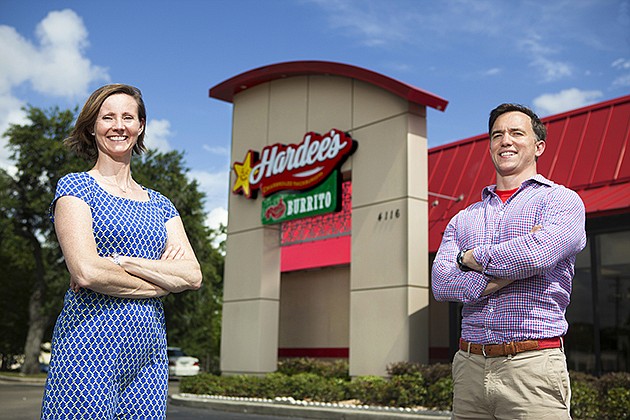After working eight years climbing the corporate ladder after spending five years moving up in the military ranks, Emily and Jack Kemp realized they didn't want to wait any longer to get to the top. So they decided to buy their own business.
The couple wanted to find an opportunity that mirrored the military structure to which they had become accustomed. They landed on quick-service restaurants, where they manage teams similar in size to an Army platoon.
For two-and-a-half years, the couple searched for franchise opportunities, looking for the right brand with the right deal. Evaluating data and information from bankers, brokers, industry publications, conferences and brand materials, they considered 74 different deals in the burger space before eventually landing on Hardee's.
In July 2013, the Kemps moved from outside Boston to buy 10 Tampa-area Hardee's locations from the 54-year-old burger chain, with a goal to break ground on five new restaurants in the next two years. They are funding the venture with their personal savings combined with a bank loan covering 75% of the investment. They believe they are buying into the brand “in the upswing,” and hope to build their initial investment to open 50 locations in Florida over the next 20 years, according to Jack.
Although the two don't have restaurant experience, they do have a heavy arsenal of business and team-building knowledge. Both graduated from West Point, both left the Army with the rank of captain, and both have M.B.A.s. Jack's experience in the corporate world comes from his time as vice president and CFO for a $600 million segment of OneBeacon Services, a public services financial company. Emily's most recent job was leading private equity fundraising efforts at a boutique real estate investment company.
The Kemps named their company Phase Three Star, because they felt phase one of their lives was in the Army, phase two in corporate America and phase three is now this new venture. The star is in reference to the Hardee's logo.
Developing Tampa
Through their research, they determined the Tampa area to be the most promising opportunity to expand the brand's reach, Jack says. In areas of the country where there is already market saturation, like in North Carolina, there is one Hardee's for every 35,000 people. Those kinds of numbers make Tampa “a phenomenal opportunity for growth,” he says.
It can be difficult to prioritize growth opportunities, according to Jack. “There are a number of markets in the greater Tampa area where we know we can do well, but we spend a great deal of time working through the projected economics and making sure that we don't outgrow the operational capabilities of the company,” he says.
Before Jack and Emily get too wrapped up in expansion, they are focusing on opening their first new location in Plant City this month. The couple is working hard to make sure they have the management, people, and processes in place to grow. “Good food is important, but much more important is building a good team,” Jack says.
With a background in development, looking for new opportunities is Emily's specialty. In addition to the Plant City location, the couple has two other sites under contract, and are almost ready “to put the foot on the gas on development,” Jack says.
Revising operations
Jack, on the other hand, focuses on the operations and finance side of the business. In fact, one of the reasons they settled on quick-service was to align Jack's skill set with the challenges that quick service businesses face — making operations as efficient as possible.
Though Jack says “we weren't looking for a turnaround situation (where we would be) in with a wrench banging on stuff day one,” he has made a few key changes to operations.
One of the first steps was adding additional employees to improve customer service and minimize wait times for food. Starting with 275 employees, they've grown to 400 employees. They tried to keep health plans and hours as good as or better than when the company was owned by corporate, to “keep as much of their lives the same as possible,” Emily says.
They've also analyzed the hours of operation where there's the most traffic to determine how long they should remain open. Corporate kept locations open from 5 a.m. to midnight, but the Kemps have decided to cut early morning and late-night hours at locations where traffic is low.
Instead of working from his home office, Jack sets up shop in one of the stores to make himself more visible to employees. It also allows him to be on site to coach and train, interact with the team and understand when additional resources are needed.
And training is an important part of making the restaurant run efficiently and profitably.
“What happens behind the counter is complicated,” Emily says. “It's fast, hot, it has to be efficient, you have to get the orders right, you're multitasking and customer-focused.”
Becoming entrenched
But the couple was pleasantly surprised to find that managing a crew of 10 to 11 people at a time felt very similar to leading a platoon.
With the new store in Plant City, the Kemps are starting from scratch, hiring 60 people from crew members through a general manager. Retention can be a challenge, as the industry is known for high turnover.
To recruit employees, the Kemps are starting a “Pom Pom Program,” where they provide pom poms at football games in local high schools' colors. They are also encouraging managers to get out of the store to build relationships — to meet employees and bring business in the door. “Our store managers are not sitting in starship Hardee's, they have to get out there and interact,” Jack says.
A second challenge is re-familiarizing people with the Hardee's brand. The Kemps purchased radio spots and are looking for more ways to engage in the community. According to Jack, Hardee's corporate has also kicked off a national cable campaign that “is hitting more of our target lunch and dinner audience — 18- to 24-year-old 'young hungry guys.'”
For a Hardee's store, the average volume is about $1.2 million, Jack says. He hopes to increase that to $1.5 million in the next few years. He's convinced if he can get people to try the Black Angus burger, tacos, or the Hardee's breakfast, he can get them to come back. The key is “service with a smile,” he says.
Despite the challenges, the Kemps are certain that forcing themselves off the corporate track was the best decision they've ever made. Many of Jack's friends from Harvard Business School talked about wanting to start a business, “and they're still just talking about it,” he says. “Sometimes execution is more important than the perfect plan.”
“You hear you don't want to own a restaurant and you take that as gospel,” Emily says, “But this is actually a great fit for us.”
Executive Summary
Issue. Development Industry. Quick-service restaurants Key. Building a team
Army Practice
Jack and Emily Kemp say working in a Hardee's is just “like the Army, but different uniforms.” And running the business is just like running a platoon. It's all about showing up “on time, in uniform, with your name tag, looking clean with a smile on your face and having discipline,” Emily says. Looking back at their rise through the military rankings, they say they understand where each of their employees fits in the system.
For example, the Kemps started their careers with the Army in the platoon, or the “lowest common denominator,” Emily says. This position is similar to a Hardee's crew person, making it easy to understand where employees are coming from.
Emily worked her way up in the ranks from a platoon leader to a company executive officer, to brigade staff and eventually to assistant for a four-star general. Working for the general and understanding what he cared about is like working with Hardee's corporate, Emily says. Using this structure of thought, the Kemps say they can make decisions both tactically and strategically.
The key to success is teamwork and setting clear objectives, Jack says. “My time as a platoon leader prepared me better than business school.”






